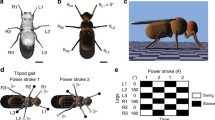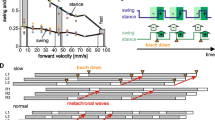Abstract
Locomotion of stick insects climbing over gaps of more than twice their step length has proved to be a useful paradigm to investigate how locomotor behaviour is adapted to external conditions. In this study, swing amplitudes and extreme positions of single steps from gap-crossing sequences have been analysed and compared to corresponding parameters of undisturbed walking. We show that adaptations of the basic mechanisms concern movements of single legs as well as the coordination between the legs. Slowing down of stance velocity, searching movements of legs in protraction and the generation of short steps are crucial prerequisites in the gap-crossing task. The rules of leg coordination described for stick insect walking seem to be modified, and load on the supporting legs is assumed to have a major effect on coordination especially in slow walking. Stepping into the gap with a front leg and antennal contact with the far edge of the gap provide information, as both events influence the following leg movements, whereas antennal “non-contact” seems not to contain information. Integration of these results into the model of the walking controller can improve our understanding of insect locomotion in highly irregular environments.





Similar content being viewed by others
Abbreviations
- AEP:
-
anterior extreme position
- fAEP:
-
fictive anterior extreme position
- PEP:
-
posterior extreme position
- TOT:
-
treading-on-tarsus
References
Bässler U (1977) Sense organs in the femur of the stick insect and their relevance to the control of position of the femur-tibia-joint. J Comp Physiol A 121:99–113
Bässler U (1983) Neural basis of elementary behaviour in stick insects. Springer, Berlin Heidelberg New York
Bässler U, Büschges A (1998) Pattern generation for stick insect walking movements—multisensory control of a locomotor program. Brain Res Rev 27:65–88
Bläsing B, Cruse H (2004) Stick insect locomotion in a complex environment: climbing over large gaps. J Exp Biol (in press)
Brooks R (1991) Intelligence without reason. Proceedings of the 12th International Joint Conference on Artificial Intelligence (IJCAI-91)
Cruse H (1976a) The function of the legs in the free walking stick insect, Carausius morosus. J Comp Physiol A 112:235–262
Cruse H (1976b) The control of the body position in the stick insect (Carausius morosus) when walking over uneven surfaces. Biol Cybern 24:25–33
Cruse H (1979) The control of the anterior extreme position of the hind leg of a walking insect. Carausius morosus. Physiol Entomol 4:121–124
Cruse H (1985a) Coactivating influences between neighbouring legs in walking insects. J Exp Biol 114:513–519
Cruse H (1985b) Which parameters control the leg movement of a walking insect? II. The start of the swing phase. J Exp Biol 116:357–362
Cruse H (1990) What mechanisms coordinate leg movement in walking arthropods? TINS 13:15–21
Cruse H, Epstein S (1982) Peripheral influences on the movement of the legs in a walking insect Carausius morosus. J Exp Biol 101:161–170
Cruse H, Frantsevich L (1997) The stick insect Obrimus asperrimus (Phasmida: Bacillidae) walking on different surfaces. J Insect Physiol 43:447–455
Cruse H, Saxler G (1980) Oscillations of force in the standing legs of a walking insect (Carausius morosus). Biol Cybern 36:159–163
Cruse H, Schwarze W (1988) Mechanisms of coupling between the ipsilateral legs of a walking insect (Carausius morosus). J Exp Biol 138:455–469
Cruse H, Kindermann T, Schumm M, Dean J, Schmitz J (1998) Walknet—a biologically inspired network to control six-legged walking. Neural Networks 11:1435–1447
Dean J, Wendler G (1982) Stick insect walking on a wheel: perturbations induced by obstruction of leg protraction. J Comp Physiol 148:195–207
Dean J, Wendler G (1983) Stick insect locomotion on a wheel: interleg coordination of leg position. J Exp Biol 103:203–216
Dean J, Wendler G (1984) Stick insect locomotion on a wheel: patterns of stopping and starting. J Exp Biol 110:203–216
Delcomyn F (1985) Factors regulating insect walking. Annu Rev Entomol 30:239–256
Dürr V (2001) Stereotypic leg searching-movements in the stick insect: kinematic analysis, behavioural context and simulation. J Exp Biol 204:1589–1604
Dürr V, Bläsing B (2000) Antennal movements of two stick insect species: spatio-temporal coordination with leg movements. Zoology 103 [Suppl III (DZG 93.1)]:17
Frantsevich I, Frantsevich L (1996) Space constancy in form perception by the stick insect. Naturwissenschaften 83:323–324
Graham D (1972) A behavioural analysis of the temporal organisation of walking movements in the 1st instar and adult stick insect (Carausius morosus). J Comp Physiol 81:23–52
Graham D (1979) Effects of circum-oesophageal lesion on the behaviour of the stick insect Carausius morosus. 2. Changes in walking co-ordination. Biol Cybern 32:147–152
Graham D (1985) Pattern and control of walking in insects. Adv Insect Physiol 18:31–140
Graham D, Epstein S (1985) Behaviour and motor output for an insect walking on a slippery surface. J Exp Biol 118:287–296
Kindermann T (2002) Behavior and adaptability of a six-legged walking system with highly distributed control. Adapt Behav 9:16–41
Pearson KG (1972) Central programming and reflex control of walking in the cockroach. J Exp Biol 56:173–193
Pearson KG, Franklin R (1984) Characteristics of leg movement and patterns of coordination in locusts walking on rough terrain. Int J Robot Res 3:101–112
Rixe A (1995) Geometrische und temporale Muster der Bein- und Körperbewegungen beim Kurvenlauf der Stabheuschrecke Carausius morosus. Diplomarbeit, Fakultät für Biologie, Universität Bielefeld
Schmitz J, Hassfeld G (1989) The treading-on-tarsus reflex in stick insects: phase dependence and modifications of the motor output during walking. J Exp Biol 143:373–388
Wagner H (1996) Verbesserungen der Beinkoordination in einem Laufmodell der Stabheuschrecke mit Hilfe genetischer Algorithmen. Diplomarbeit. Technische Fakultät, Universität Bielefeld
Watson JT, Ritzmann RE, Zill SN, Pollack AJ (2002) Control of obstacle climbing in the cockroach Blaberus discoidalis. I. Kinematics. J Comp Physiol A 188:39–53
Wendler G (1964) Laufen und Stehen der Stabheuschrecke Carausius morosus: Sinnesborstenfelder in den Beingelenken als Glieder von Regelkreisen. Z Vergl Physiol 48:198–250
Acknowledgements
This work was supported by grant no Cr 58/9-3 of the DFG and the graduate programme “Verhaltensstrategien und Verhaltensoptimierung” (DFG).
Author information
Authors and Affiliations
Corresponding author
Rights and permissions
About this article
Cite this article
Bläsing, B., Cruse, H. Mechanisms of stick insect locomotion in a gap-crossing paradigm. J Comp Physiol A 190, 173–183 (2004). https://doi.org/10.1007/s00359-003-0482-3
Received:
Revised:
Accepted:
Published:
Issue Date:
DOI: https://doi.org/10.1007/s00359-003-0482-3




